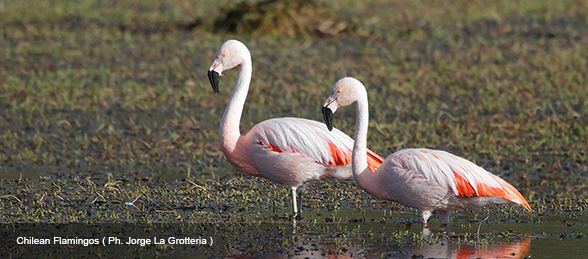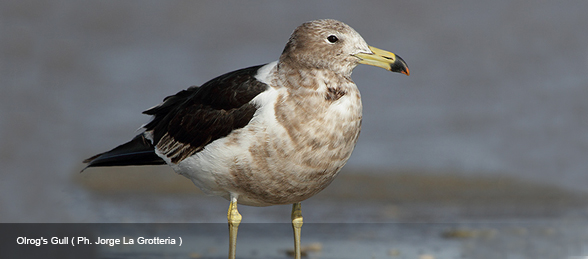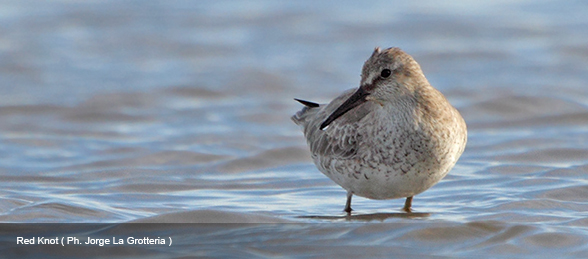Punta Rasa
Punta Rasa & San Clemente del Tuyú GO TOP
These wonderful places are located about 300 kilometres SE from Buenos Aires, in the geographical outer limit of La Plata river's estuary. That area is probably the best place in the region for watching migratory waders (sandpipers and plovers), some of them summer visitors from the Northern Hemisphere, and some others are winter visitors from Patagonia. But it also has a lot to offer regarding aquatic and Pampas grassland birds.

The town of San Clemente del Tuyú is the northernmost town by the sea in Argentina, having a variety of hotels and other kinds of accommodations, restaurants and a nice centre for tourists, specially in the summer. It also has a small port from where many fishing vessels depart every day for fishing out in the sea and inside of Samborombon bay. That port is one of the best places for birding in the area, especially during the low tide, when most of the waders are actively looking for their food in the estuary. Chilean Flamingoes, Roseate Spoonbills, Wood Storks, Black-necked Stilts and ducks are some of the aquatic non-migrants that use the port area as a feeding ground, while Greater and Lesser Yellowlegs, American Golden-plovers, Black-bellied Plovers and Hudsonian Godwits are found in large numbers when they stop in their migration to either their breeding grounds (near the Arctic) or their feeding grounds in southern Patagonia.
Other birds found in all this area are the Black Skimmers, which can be seen feeding even at night because of their unique fishing technique that does not needs their vision.

From the port area, a short car ride would take you to the entrance of Punta Rasa natural reserve. This peninsula marks the outermost edge of La Plata river estuary, and is especially good for migratory waders. On the way to the beach the landscape shows a very interesting grassland with Pampas Grass and other pampean weeds. This is the habitat for some specialties such as Hudson's Canastero, Bay-capped Wren-spinetail, Sedge Wren, Long-tailed Reed-finch, the common Great Pampa-finch and the remarkable Spectacled Tyrant.

Once on the beach is easy to note the importance of the place for the migratory shore birds. Although sometimes the beach can be a little crowded with vehicles and people playing wind sports, the birds are still in the area. In addition to all the birds quoted before (that are found here too), Punta Rasa is one of the best places for finding the endangered Olrog's Gull. Enormous flocks of Common Terns can be found here in the right moment of the year. Also, Snowy-crowned, Sandwich and Royal Terns are found among the common terns. Parasitic Jaeger, a mainly pelagic bird, usually can be seen from the shore, chasing birds. But among the migratory waders there are two species that traditionally make an important stop here on their journey: Red Knot and Whimbrel. There are also some migrants that arrive from Patagonia in the end of the summer, and spend the winter in the area. The Two-banded Plover and Rufous-chested Dotterel are some of them.
A special “bonus” of this place, during windy days, can be a sight of pelagic birds from the shore, such as the
Finally, the fields surrounding the area are very good for some grassland species too, such as the Greater Rhea, Spotted Nothura and White-tailed Hawk, without mentioning that not far from San Clemente there is the last remaining population of the very endangered Pampa's Deer. Foxes, wild cats, armadillos and Capibaras are among the mammals that can be found in the area too.
